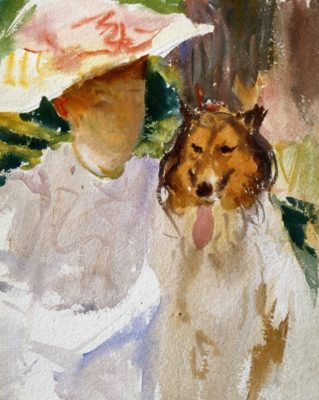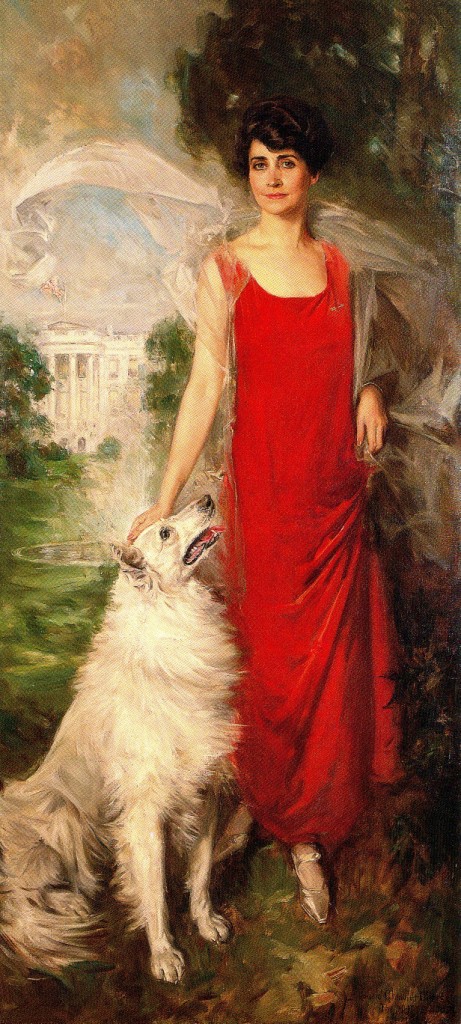
As a dog owner, President Lyndon Johnson was best known for his Beagles, “Him” and “Her,” but he also had several other dogs during his administration, and one of his favorites was a white Collie named “Blanco,” a holiday gift from a 9-year-old girl from Illinois.
Johnson, however, was not the first president to have a white Collie. He was preceded by Calvin Coolidge who had two white Collies, including, “Rob Roy” said to be Coolidge’s very favorite pet among the menagerie of animals he kept. Prior to Coolidge’s election, enthusiasm for the white Collie was gaining momentum. In the January 1917 issue of The Dog Fancier, S.J. Twyman made mention of breeders specializing in white Collies and raised the question: Ought the white Collie not have a name of its own? He suggested the Columbian Collie, though he didn’t offer an explanation for the choice.

Watercolor portrait of Grace Goodhue Coolidge and Rob Roy by artist Howard Chandler Christy circa 1924
The White Collie hit the peak of its popularity during Coolidge’s term, and in show rings, the percentage of whites shown was statistically close to the other colors being shown. That said, white Collies were also being bred by indiscriminate breeders who had little regard for quality just to meet demand. This led to squabbles among white Collie people alarmed by the number of all-white collies suffering from a lack of type. Some of the problem was resolved with Coolidge’s death and the keenness for white Collies faded. While some fanciers carried on with the cause of the white dogs, enthusiasm wasn’t what it was. Indeed, some breeders came along who regarded the color as defective or a liability in the show ring.
In Collies, the two base color genes are sable (or brown, the dominant color), and tri-colored, or black which is which is black recessive. A Collie puppy will be sable if s/he gets a dominant brown gene from each parent, but if s/he inherits the recessive black gene from each parent, the youngster will be a tri-color. If they get one brown and one black gene, they’ll be sable in appearance, but technically are “tri-factored sables.”
When a hair follicle doesn’t get melanosomes, the hair strand it forms is un-pigmented, white, as in the majority coat of a white Collie or the neck region of colored collies. A study by Izabella Baranowska Körberg found that the white coat in collies is probably caused by alleles for piebald. Of the two alleles for the white spotting gene in collies, one is “fixed,” and one “separates” (piebald). Piebald seems to be the allele responsible for color-headed whites.A white Collie can be the result of breeding two white parents or white factored parents. The color white is a recessive gene, and depending on the other gene received, the white collie may have tri, sable or blue merle markings that are inherited independently, and can occur in combination with any of them. There is still the presence of sable, tri-color or blue merle markings, and ideally, the white content is 80 per cent.
For a marvelous overview of the history of the white Collie, don’t miss the article presented by Gayle Kaye at Chelsea Collies here. To learn more about color, read about the work Leigh Anne Clark, PhD is doing.
Image:”Woman with Collie” by John Singer Sargent

I groom a mostly white collie, sable on the ears and a small patch over the right hip. Everything else is stark white.
I used to groom a solid white, dead and completely blind due to like of ocular orb development, a concern when breeding Merle to Merle. ( Both came to me through a local come rescue)
I’m no expert on collie colour genetics but I have heard some horror stories about trying to get a “white” collie by breeding 2 heavy white marked Merle’s, and the health problems in the offspring that occur.
I’d love to hear more thoughts on this by people in the know.
We would too, Kaela! We actually had a paragraph about the merles but deleted it because we’re neither geneticists or Collie breeders. We’re rather have the experts weigh in on this.
I am no expert. I would love to read more about the white factored and merle colorings. I own 2 sable merle collies. Their dam is a white factored sable and their sire is a blue merle.
Fingers crossed that we get actual experts to respond, Leslie!
A merle to merle breeding can produce a double dilute collie. This collie appears to be a white, but it is not. It is geneticly a merle. The double dilute merle can be deaf and or blind. This defect is due to doubling of the dilution gene, not due to a gene for the color white. At one time these double dilutes were used in breeding programs to produce blue merles. A double dilute bred to a tri would ptoduce a litter of all normal blue mereles.
A true white is not defective of sight, nor hearing. They carry normal color genes with a white producing gene. A true white will have a colored head (any of the 3 colors) and is to have white over 80% or more of its body, not counting the collar area. It is extremely rare for a pure white head, that seems to have been lost over the years.
Great information, Karla, thanks for sharing it!
Karla is right on with her facts about the wonderful white collie. The collie breed people do a real disservice to the white collie by calling a Double Dilution Merle as a White Merle. It causes collie people to some how confuse the two because of the double use of the word “White.” Recently I spoke with a famous successful collie breeder who has been breeding collies for about half a century. I had to correct the statement that you can’t breed two white collies together. If the quality is bred for first, there is no better breeding than white to white if you are smitten by their beauty!
My white Collie, Skye; named after the Isle of Skye in northern Scotland where the Collie breed is said to have originated. She is neither blind nor deaf. She loves attention, especially from children. She also has a particular affinity for the developmentally challenged and disabled. I don’t know how she knows, but she consistently showers those with disabilities – like Down’s syndrome – extra attention.
Dogs are simply amazing, and we may never know HOW they know who among us is most in need of their special attention. We don’t always deserve them.
I have a pure white collie from neck to tail with light brown markings on her head and face. She will be 4 years old next month and is in perfect health. I got her from Palmhaven collies in central Florida.